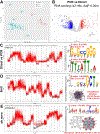Integrated RNA Sequencing Reveals Epigenetic Impacts of Diesel Particulate Matter Exposure in Human Cerebral Organoids
- PMID: 33657557
- PMCID: PMC7990702
- DOI: 10.1159/000513536
Integrated RNA Sequencing Reveals Epigenetic Impacts of Diesel Particulate Matter Exposure in Human Cerebral Organoids
Abstract
Autism spectrum disorder (ASD) manifests early in childhood. While genetic variants increase risk for ASD, a growing body of literature has established that in utero chemical exposures also contribute to ASD risk. These chemicals include air-based pollutants like diesel particulate matter (DPM). A combination of single-cell and direct transcriptomics of DPM-exposed human-induced pluripotent stem cell-derived cerebral organoids revealed toxicogenomic effects of DPM exposure during fetal brain development. Direct transcriptomics, sequencing RNA bases via Nanopore, revealed that cerebral organoids contain extensive RNA modifications, with DPM-altering cytosine methylation in oxidative mitochondrial transcripts expressed in outer radial glia cells. Single-cell transcriptomics further confirmed an oxidative phosphorylation change in cell groups such as outer radial glia upon DPM exposure. This approach highlights how DPM exposure perturbs normal mitochondrial function and cellular respiration during early brain development, which may contribute to developmental disorders like ASD by altering neurodevelopment.
Keywords: Autism; Cerebral organoids; Diesel particulate matter; Epigenetics; Transcriptomics.
© 2021 S. Karger AG, Basel.
Conflict of interest statement
Conflict of Interest Statement
The authors have no conflicts of interest to declare.
Figures




Similar articles
-
Environmental Epigenetics of Diesel Particulate Matter Toxicogenomics.Int J Environ Res Public Health. 2020 Oct 10;17(20):7386. doi: 10.3390/ijerph17207386. Int J Environ Res Public Health. 2020. PMID: 33050454 Free PMC article.
-
Part 1. Assessment of carcinogenicity and biologic responses in rats after lifetime inhalation of new-technology diesel exhaust in the ACES bioassay.Res Rep Health Eff Inst. 2015 Jan;(184):9-44; discussion 141-71. Res Rep Health Eff Inst. 2015. PMID: 25842615
-
Transgenerational effects of diesel particulate matter on Caenorhabditis elegans through maternal and multigenerational exposure.Ecotoxicol Environ Saf. 2019 Apr 15;170:635-643. doi: 10.1016/j.ecoenv.2018.12.027. Epub 2018 Dec 19. Ecotoxicol Environ Saf. 2019. PMID: 30579164
-
A critical review of developmental exposure to particulate matter, autism spectrum disorder, and attention deficit hyperactivity disorder.J Environ Sci Health A Tox Hazard Subst Environ Eng. 2018 Jan 28;53(2):174-204. doi: 10.1080/10934529.2017.1383121. Epub 2017 Nov 20. J Environ Sci Health A Tox Hazard Subst Environ Eng. 2018. PMID: 29157090 Review.
-
Diesel exhaust particles.Inhal Toxicol. 2007;19 Suppl 1:241-4. doi: 10.1080/08958370701498075. Inhal Toxicol. 2007. PMID: 17886072 Review.
Cited by
-
Emerging Role of ODC1 in Neurodevelopmental Disorders and Brain Development.Genes (Basel). 2021 Mar 25;12(4):470. doi: 10.3390/genes12040470. Genes (Basel). 2021. PMID: 33806076 Free PMC article.
-
Invited Perspective: The Silent Threat-Air Pollution's Link to Arrhythmias.Environ Health Perspect. 2023 Nov;131(11):111301. doi: 10.1289/EHP13720. Epub 2023 Nov 1. Environ Health Perspect. 2023. PMID: 37909724 Free PMC article. No abstract available.
-
Human pluripotent stem cell (hPSC) and organoid models of autism: opportunities and limitations.Transl Psychiatry. 2023 Jun 21;13(1):217. doi: 10.1038/s41398-023-02510-6. Transl Psychiatry. 2023. PMID: 37344450 Free PMC article. Review.
-
Engineering human midbrain organoid microphysiological systems to model prenatal PFOS exposure.Sci Total Environ. 2024 Oct 15;947:174478. doi: 10.1016/j.scitotenv.2024.174478. Epub 2024 Jul 2. Sci Total Environ. 2024. PMID: 38964381 Free PMC article.
-
Common analysis of direct RNA sequencinG CUrrently leads to misidentification of m5C at GCU motifs.Life Sci Alliance. 2023 Nov 29;7(2):e202302201. doi: 10.26508/lsa.202302201. Print 2024 Feb. Life Sci Alliance. 2023. PMID: 38030223 Free PMC article.
References
-
- Wells JCK. The thrifty phenotype as an adaptive maternal effect. Biological Reviews. 2007;82(1):143–72. - PubMed
-
- Moody EC, Cantoral A, Tamayo-Ortiz M, Pizano-Zárate MaL, Schnaas L, Kloog I, et al. Association of Prenatal and Perinatal Exposures to Particulate Matter With Changes in Hemoglobin A1c Levels in Children Aged 4 to 6 Years. JAMA Netw Open. 2019. December;2(12). DOI: 10.1001/jamanetworkopen.2019.17643 - DOI - PMC - PubMed
Publication types
MeSH terms
Substances
Grants and funding
LinkOut - more resources
Full Text Sources
Other Literature Sources

